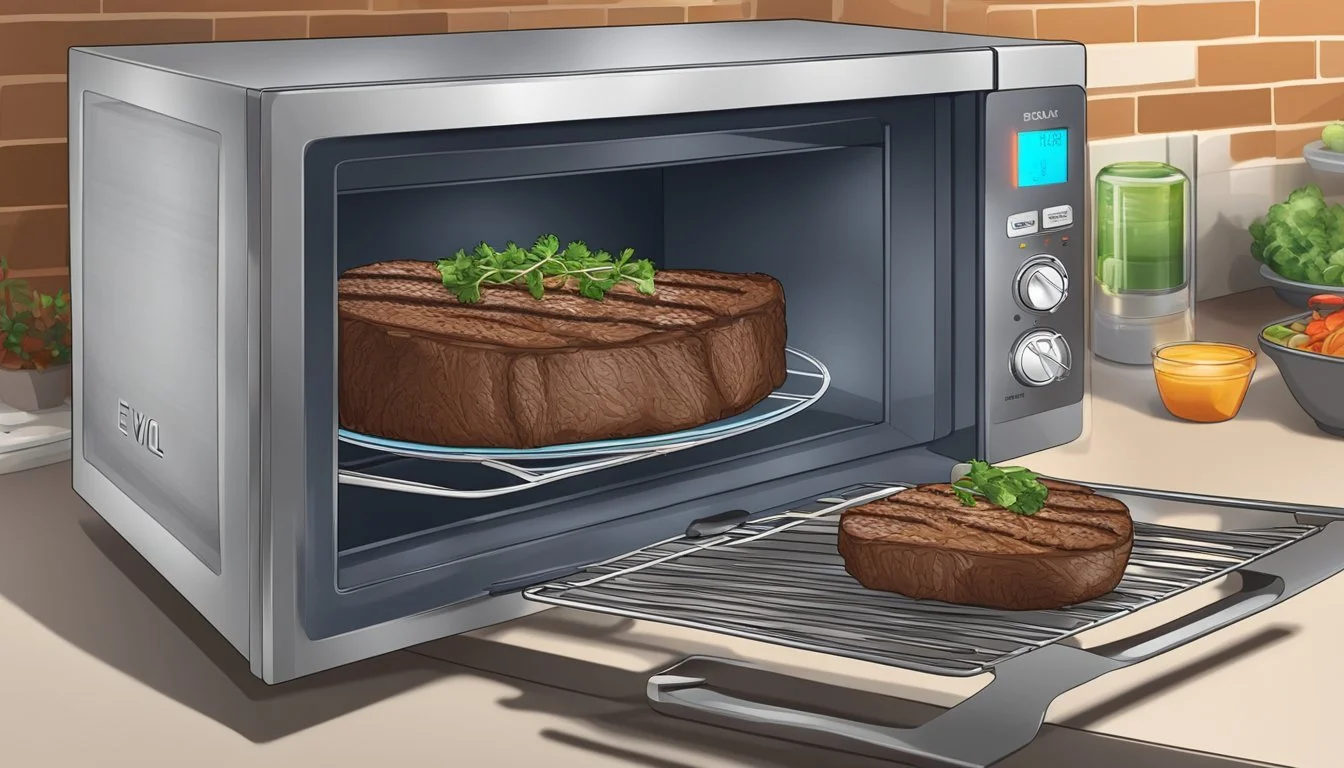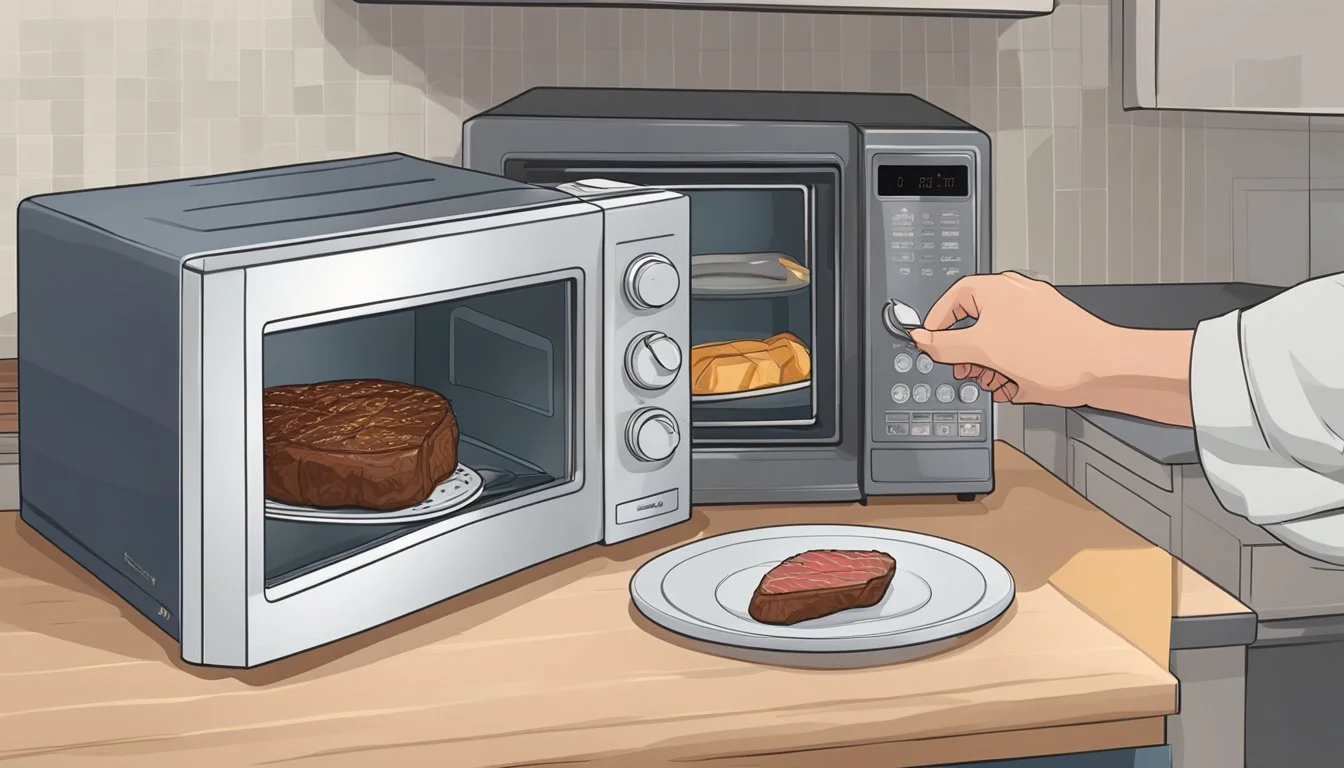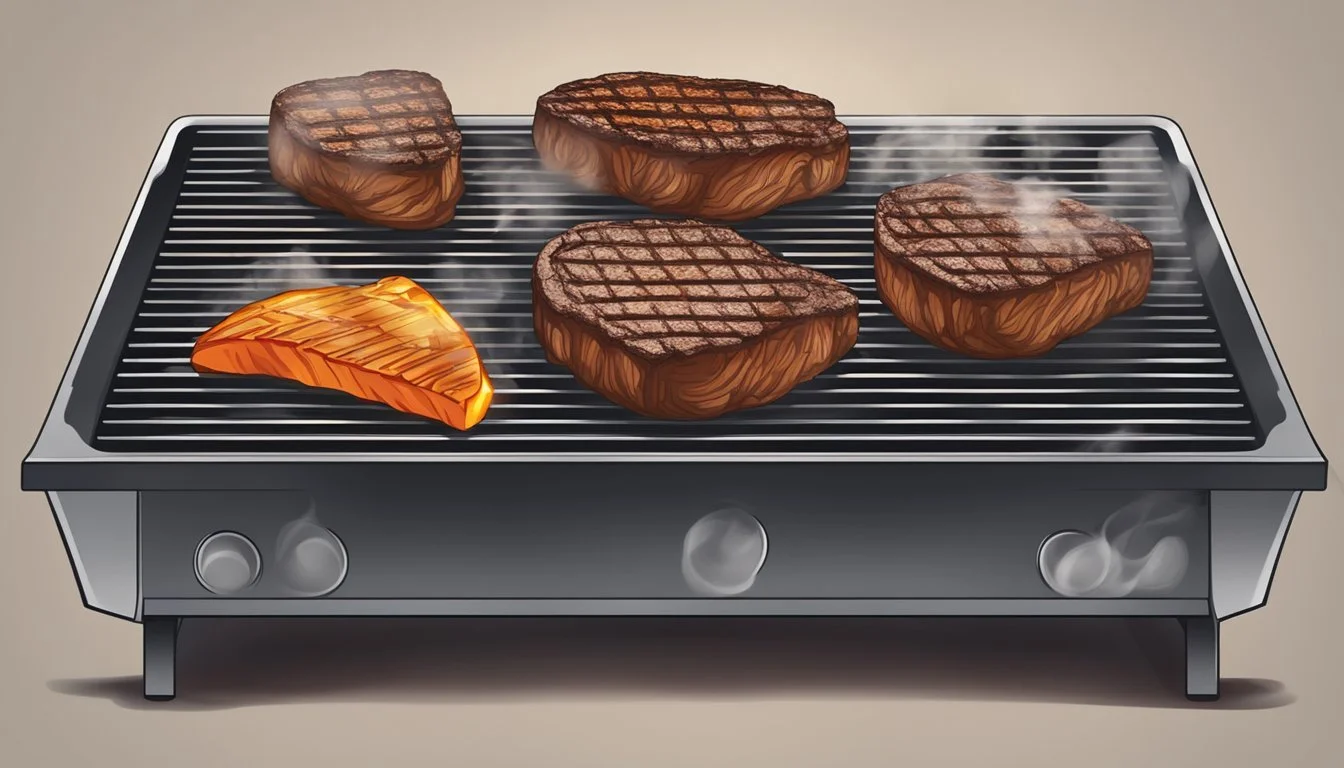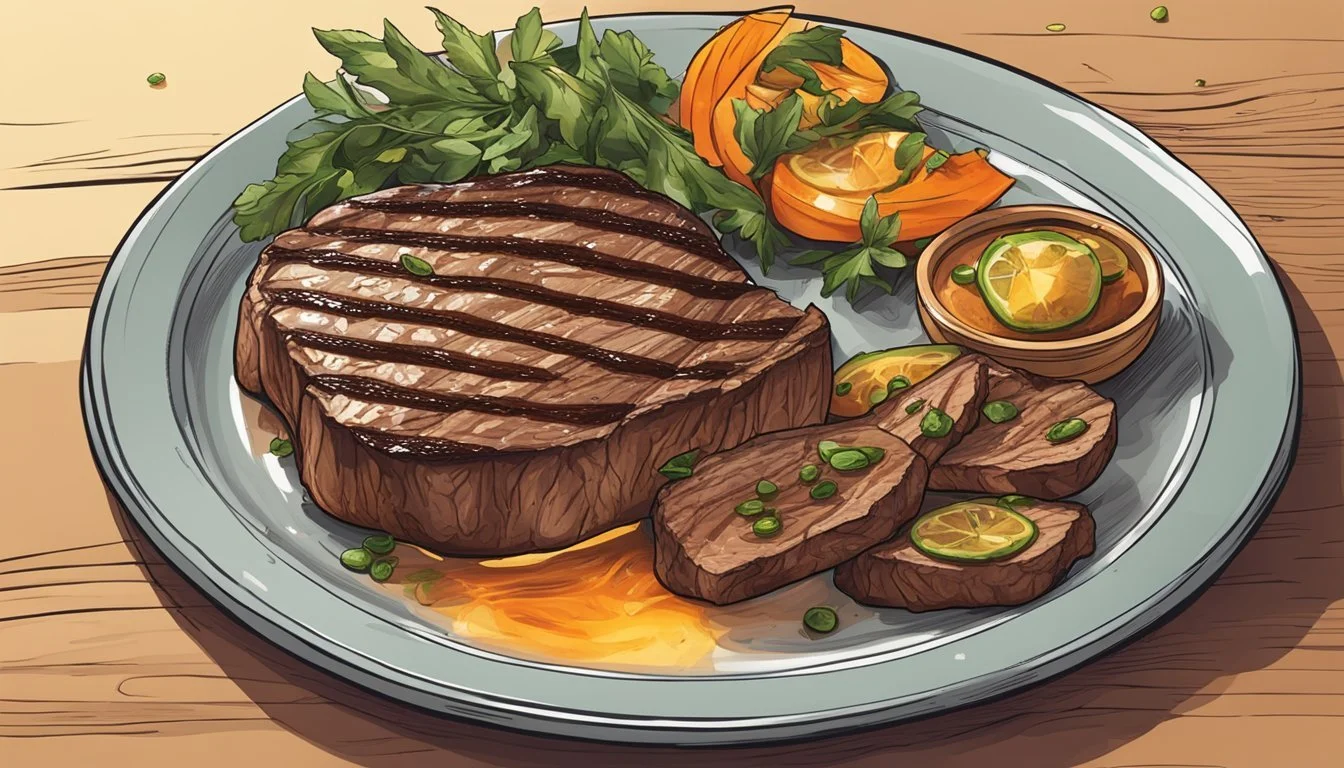How to Reheat Evol Fire Grilled Steak
Best Methods for Perfect Results
Reheating Evol Fire Grilled Steak can be a delightful experience when done correctly, ensuring that the flavors and textures remain intact. Preheat the oven to 250 degrees Fahrenheit and place the steak on a wire rack over a baking sheet to achieve an evenly heated steak without drying it out. This method allows the air to circulate around the steak, promoting even cooking.
Alternatively, for those who prefer a quicker method, using an air fryer is also a great option. Preheat the air fryer to 350 degrees Fahrenheit, and cook the steak for a few minutes until it reaches your preferred temperature. This method is especially effective for achieving a crispy exterior while maintaining a juicy interior.
For microwave reheating, place the steak on a microwave-safe plate with a damp paper towel loosely laid over it. This helps keep the steak moist. Set the power to medium and heat in 30-second intervals, flipping the steak as needed, until it's warmed to your liking. Reheating Evol Fire Grilled Steak can be simple and satisfying with the right approach.
Understanding the Fundamentals of Steak Reheating
Reheating steak requires careful attention to a few key principles to ensure the meat retains its flavor and tenderness. This involves understanding the importance of bringing the steak to room temperature and identifying the steak's doneness before reheating.
Importance of Bringing Steak to Room Temperature
Bringing steak to room temperature is crucial before reheating. This step ensures even heat distribution throughout the meat. When a steak is taken directly from the fridge to a heat source, it can result in uneven heating, causing parts of the steak to overcook while others remain cold.
Allowing the steak to rest at room temperature for about 20-30 minutes helps prevent this issue. This way, the internal temperature of the steak is more balanced and can reheat uniformly. The process is especially important for thicker cuts, which are more likely to retain cold spots if not adequately warmed beforehand. Room temperature steak reheats more consistently and retains its flavors better.
Identifying Steak Doneness Before Reheating
Knowing the doneness of your leftover steak is critical before you begin reheating. The doneness level affects how you should reheat the steak to avoid overcooking. For instance, a steak that was originally cooked to medium-rare should be reheated gently to prevent it from becoming medium or well-done.
Use a meat thermometer to check the internal temperature. Medium-rare steaks should be reheated just until the internal temperature reaches around 110°F. Thicker steaks might require more careful monitoring, while thinner cuts can be reheated more quickly.
Recognizing the steak’s doneness helps tailor the reheating method to maintain the desired texture and flavor of the meat. Overcooking can make the steak tough and dry, so it's essential to reheat with the initial doneness in mind.
Preparation Steps Before Reheating
Properly preparing Evol Fire Grilled Steak before reheating ensures it will be flavorful and tender. Key preparation steps include selecting the right reheating method and handling the steak for optimal results.
Selecting the Reheating Method
Choosing the right method to reheat the steak is crucial. Different methods offer varying results in terms of texture and flavor. Options include the oven, stovetop, grill, air fryer, and sous vide. Each has its benefits; for instance, using an oven can provide even heating, while a stovetop allows for a quick sear to re-crisp the outer layer.
Oven: Preheat to 250°F. Heat the steak on a wire rack set over a baking sheet.
Stovetop: Use medium-high heat with a bit of oil for a quick sear.
Grill: Ideal for adding a smoky flavor. Preheat the grill to medium.
Air Fryer: Set to 350°F for 3-4 minutes.
Sous Vide: Precise temperature control, reheat at 130°F for 20-30 minutes.
Thawing and Drying the Steak if Necessary
If the steak is frozen, it must be thoroughly thawed to ensure even reheating. Let it sit in the refrigerator overnight or use a cold water bath.
Thawing in the refrigerator is safest, preventing bacteria growth. Alternatively, submerge the steak in a sealed plastic bag in cold water, changing the water every 30 minutes until fully thawed.
Once thawed, pat the steak dry with paper towels. This prevents excess moisture from hindering the searing process. Drying ensures a crispy exterior and lets the steak heat more evenly, retaining its juicy, tender texture.
Always let the steak rest at room temperature for 10-30 minutes before reheating, as this brings the internal temperature closer to ambient, allowing for more even heating.
Oven Reheating Method
Reheating Evol Fire Grilled Steak in the oven can be an excellent way to achieve a warm, evenly cooked steak while preserving its juices and flavor. Key techniques include using low temperatures, creating a moist environment with aluminum foil, and employing either a baking sheet or wire rack.
Using Low Temperature for Even Warming
Setting the oven to a low temperature, around 250 degrees Fahrenheit, ensures the steak warms evenly. Low temperatures prevent the steak from drying out or overcooking from the outside in. This method typically takes 20-30 minutes, allowing the steak to reach an internal temperature of about 110 degrees Fahrenheit.
Regularly check the steak's temperature with a meat thermometer to avoid overcooking. This slow reheating process retains the steak's natural moisture, making each bite as juicy as the first time it was cooked.
Creating a Moist Environment with Foil
Covering the steak with aluminum foil while reheating can help create a moist environment. Aluminum foil traps steam and juices, preventing the steak from drying out. This technique is particularly useful for retaining the steak's original flavors and tenderness.
To implement this method, wrap the steak loosely in foil before placing it in the oven. Make sure to crimp the edges to seal in the moisture, creating a tent-like structure. This allows the steam to circulate around the steak, ensuring even heating.
Using a Baking Sheet or Wire Rack
Using either a baking sheet or wire rack is essential during the reheating process. A wire rack, placed over a baking sheet, elevates the steak, allowing hot air to circulate around it. This setup helps the steak cook evenly on all sides, preventing the bottom from getting soggy.
If a wire rack is unavailable, a baking sheet alone will work. Place the steak directly on the sheet or use a cooling rack on top of the sheet. Ensure that any juices that accumulate during reheating are collected by the baking sheet, which can be used to baste the steak if desired.
Stovetop Reheating Technique
Reheating steak on the stovetop ensures a crispy exterior while maintaining a moist and flavorful interior. Using a cast iron skillet, the process is quick and straightforward, adding delightful texture to your steak.
Searing for a Crispy Exterior
To achieve a crispy exterior, heat a cast iron skillet over medium-high heat. Once the skillet is hot, place the steak in the pan. Sear each side for about 1-2 minutes. This short searing time is important to avoid overcooking the interior while giving it a crispy crust.
Use tongs to handle the steak, ensuring even searing on all sides. Cast iron is ideal as it retains and distributes heat evenly, making it perfect for creating that desired crispiness. Remember, the goal is to keep the interior juicy while achieving that delicious crispy exterior.
Adding Moisture with Beef Broth or Butter
After searing, adding beef broth or butter helps maintain the steak's moisture and enhances its flavor. Reduce the heat to low and add a tablespoon of butter or a few tablespoons of beef broth to the skillet.
Allow the butter to melt or the broth to heat up, then spoon the liquid over the steak. This not only keeps the steak moist but also infuses it with additional flavor. Butter gives a rich, creamy taste, while beef broth provides a savory boost.
Monitor the steak closely to prevent it from drying out, and adjust the liquid as necessary. This technique enriches the overall texture and taste, ensuring a delectable reheated steak.
Grill Reheating For Charred Flavor
To achieve a charred flavor while maintaining the steak's juiciness, it's essential to manage heat properly and use low and slow techniques to preserve texture and prevent the steak from becoming overcooked.
Managing Heat to Prevent Overcooking
Grill reheating requires careful heat management. Preheat the grill to medium heat, around 250-300°F (120-150°C). This temperature allows the steak to warm gradually, reducing the risk of overcooking the exterior while the interior comes up to temperature.
Place the steak on the grill away from direct flames. Use indirect heat by placing the steak on the cooler side of the grill, closing the lid to create an oven-like environment. Check the internal temperature frequently with a meat thermometer.
When reheating steak, aim for an internal temperature of 110°F (43°C) for a rare steak or up to 135°F (57°C) for medium. Avoid pressing down on the steak to prevent juices from escaping.
Protecting Steak Juiciness with Low Heat
Using low heat is crucial to retaining the steak's natural juices and achieving a tender texture. Start by lightly oiling the steak to help retain moisture. Cook on the grill at the same medium-low temperature, about 250-300°F (120-150°C), ensuring the heat remains consistent throughout the process.
Cover the steak loosely with aluminum foil to protect it from becoming too dry. This technique helps create a steamy environment that keeps the steak moist. Reheat for about 10-15 minutes, depending on the thickness, checking frequently with a thermometer.
Avoid flipping the steak multiple times; one or two flips should suffice. This helps in maintaining the steak's juicy interior while ensuring a flavorful, charred exterior.
Alternative Reheating Methods
When reheating Evol Fire Grilled Steak, several alternative methods can preserve its flavor and tenderness. Each technique varies in convenience and precision, impacting how well the steak retains its quality.
Microwave with Caution for Speed
For a quick option, use a microwave, but caution is necessary to avoid overcooking. Place the steak on a microwave-safe dish and cover it with damp paper towels or plastic wrap to maintain moisture. Set the microwave to medium power and heat in 30-second intervals, flipping the steak halfway through. This method may cause the steak to become soggy or rubbery if overheated, so frequent checking is important.
Sous Vide for Precision and Tenderness
The sous vide method ensures the steak remains tender and flavorful. Seal the steak in a vacuum bag and immerse it in a water bath set to 130°F for medium-rare doneness. Heat it for about an hour, depending on steak thickness. This method prevents overcooking and distributes heat evenly. The result is a steak that's nearly as good as when first grilled, maintaining tenderness and succulence.
Using Air Fryer for Convenience
An air fryer offers a balance of speed and quality. Preheat the air fryer to 350°F. Place the steak inside and cook for three minutes. Check the temperature, adding a minute or two as needed until it reaches 145°F for medium doneness. This method provides a crispy exterior while keeping the inside tender. Be sure to check periodically to avoid overcooking.
Finishing Touches and Serving
Giving your reheated Evol Fire Grilled Steak the perfect finishing touches ensures it remains juicy and flavorful, ready to impress at any meal. Resting the steak after reheating and knowing how to serve it properly are key steps to achieving this.
Resting the Reheated Steak for Juiciness
After reheating, let the steak rest for at least 5 minutes. This brief period allows the juices to redistribute within the meat, ensuring that each bite is tender and succulent. Skipping this step can result in a dry and less flavorful steak.
Use a wire rack over a baking sheet to prevent moisture buildup and sogginess. Covering the steak lightly with foil can keep it warm during the resting period without causing it to steam. This helps maintain the steak's desirable texture.
For added flavor, brush the steak with a bit of melted butter or drizzle with olive oil just before serving. A sprinkle of sea salt can also enhance the overall taste and bring out the meat's natural juiciness.
Serving Suggestions for Reheated Steak
Leftover steak can be served in various ways beyond a simple reheat. For a traditional touch, pair the steak with classic sides like mashed potatoes or roasted vegetables. If you prefer a protein-packed breakfast, serve the reheated steak with eggs for a hearty steak and eggs platter.
Transform the leftover steak into tacos by thinly slicing it and adding toppings like chopped onions, cilantro, and a squeeze of lime. This method offers a fresh twist and makes use of leftovers creatively.
Another option is to slice the steak over a salad or into a sandwich, creating a versatile dish suitable for lunch or a light dinner. Choose substantial breads like ciabatta or baguette to complement the steak without overpowering it. Include fresh greens, tomatoes, and a flavorful sauce to complete the ensemble.
Safety and Storage Tips
When reheating Evol Fire Grilled Steak, it's crucial to ensure proper storage and reheating safety to maintain quality and prevent foodborne illnesses.
Proper Storage to Maintain Quality
To keep leftover steak safe and fresh, store it in an airtight container promptly after cooking. Refrigerate within two hours of preparation to inhibit bacterial growth. For best results, the refrigerator should be set to 40°F (4°C) or below. If freezing, wrap the steak in aluminum foil or plastic wrap before placing it in a freezer-safe, airtight container. Label the container with the date to monitor its storage duration.
Proper defrosting is key to maintaining texture and flavor. Defrost steak in the refrigerator, not at room temperature, to keep it within a safe temperature range.
Assessing Reheating Safety
To ensure reheating steak is safe, check the internal temperature with an instant-read thermometer. The steak should reach an internal temperature of 165°F (74°C) to eliminate any harmful bacteria. Different methods like oven, skillet, or microwave can be used, but each requires careful monitoring. For instance, reheating steak in a 250°F oven slowly until it reaches the desired internal temperature ensures even heating.
Avoid reheating steak multiple times as this can lead to unsafe bacterial growth and loss of quality. Instead, reheat only the portion you plan to consume immediately. Water, broth, or oil can be added to maintain moisture and flavor during reheating.
Additional Tips for Optimal Reheating
Reheating Evol Fire Grilled Steak to perfection requires attention to detail, ensuring consistent heat distribution and preserving its flavor and juiciness.
Avoiding Common Reheating Mistakes
One common mistake is using too high a temperature. Always reheat steak at a low and steady temperature. This helps maintain juiciness and prevents overcooking.
For the best results, use an oven preheated to 250°F. Place the steak on a wire rack over a baking sheet to promote even heat distribution.
Microwaving steak is generally discouraged due to uneven heating, which can make the meat rubbery. If you must use a microwave, do it on low power and in short, monitored intervals.
Enhancing Flavor During Reheating
To enhance the flavor, adding a small amount of fat can be beneficial. Use a cast-iron skillet with a tablespoon of olive oil or vegetable oil. This method helps sear the steak and adds a rich texture.
Including leftover meat juices or a pat of butter can also keep the steak moist and flavorful. Spoon juices over the steak or immerse it briefly in a sauce bath while reheating.
Slicing the steak against the grain after reheating ensures tenderness, making each bite more enjoyable. These steps can transform a reheated steak into a meal that rivals its freshly cooked state.







